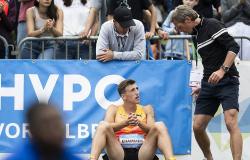Calling followers of the Slow Food movement, born in the 1980s on the Piedmontese lands set ablaze for three days by the Grande Partenza du Giro 2024: do they have some advice for slowing down the Corsa Rosa peloton and transmitting to it the deliciously simple values of this movement “good, clean and fair“?
Historically, a Grand Tour, especially the one that has crisscrossed Italy since 1909, is a matter of management and endurance. The best count their pedal strokes and spring out at the right time, most often in the third week, to snatch the first prizes with their last strength. It was still like this before Tadej Pogačar (UAE Team Emirates) ignited this 107th edition with his fiery panache which contrasts radically with the wait-and-see attitude of the leaders in 2022 or 2023.
The moment Pogacar got his hands on the 2nd stage: his perfect attack on video
It was to be expected: in Rosa, Pogi is in line with his antics from the Tour, the Vuelta and any other event where his exceptional legs allow him to do what he pleases, what’s more in the month of may ; it is also in line with performances which relegate to a more or less distant past the references built by the long history of this centuries-old sport.
More than 110km/h: “Not sure I should be proud”
In 2024, the “records” rained in from January and the classics campaign was supersonic. The tone was set from the opening weekend, with unprecedented averages on the Omloop Het Nieuwsblad (44.69km/h, Jan Tratnik) and Kuurne-Bruxelles-Kuurne (45.15km/h, Wout van Aert ). The records then became “monumental” at Sanremo (46.11km/h, Jasper Philipsen), on the Tour of Flanders (44.48km/h, Mathieu van der Poel) and at Paris-Roubaix (47.80km/h , Mathieu van der Poel).
The ride through the Hell of the North was astonishing: Cyrus Monk, 128th rider to appear in the velodrome, more than three quarters of an hour from Van der Poel (and therefore outside the deadline), was more than 2km/h faster than Fabian Cancellara during his victory in 2010… The most experienced followers quickly shrugged their shoulders: “14 years apart, we no longer talk about the same sport.”
The favorite shows itself: Van der Poel accelerates in the Trouée d’Arenberg
Also in 1996, Johan Museeuw was faster than the Cancellara of 2010. And two years earlier, Andrei Tchmil had signed a 60 kilometer solo, like Van der Poel, but he had reached Roubaix with an average of 36.16 km/h … That year, it snowed on the race.
But in 2024, the dynamic is irrepressible, on all terrains. While he broke the records at Port Ainé and Valter 2000 in Catalonia, Pogačar was stolen from the best time at Prati di Tivo, established by Alexey Lutsenko at the Giro d’Abruzzo, but we imagine the Slovenian setting the record straight its advantage Saturday on these same slopes. This time, Geraint Thomas will not be able to just observe with a disapproving pout, as when he let the Tour d’Algarve peloton go at 118km/h on a descent…
In the era of data, speeds are omnipresent. They make you fantasize. “Not sure I should be proud“, noted Michael Woods (not known for being the most skilled on his machine, after a late transition from running to cycling) when he was flashed at more than 110km/h on the Tour de France.
Slow down runners
“Progress is there and it’s difficult to go back in time, that’s cycling, that’s life”, observes Erik Zabel, who tried by all means to be as fast as possible during his career as a sprinter and who today provides technical advice to Canyon.
Removed from the pelotons for 15 years, the German observes physical developments (“each generation is sharper than the previous one“), techniques (“frames and wheels are getting faster and faster, tires grip better and offer more comfort”) and tactics (“at the time, in an event like the Ronde, there were two or three hot spots that the runners knew from experience, now the sports directors identify 25 hot spots per race”).
The sport has changed. And ultimately, different does not necessarily mean better or worse. But at this pace, cycling takes great risks, for the athletes and for the discipline itself.
The heavy falls which devastated the cycling spring have naturally brought speed back into the debates, even if attention is focused rather on the responsibilities of the organizers (laying out routes, securing dangerous areas) and the riders (taking risks, respecting the other).
The Arenberg chicane still showed us organizers trying, at the request of the peloton, to slow down the riders. This time it was a question of exploiting the urban obstacles which have multiplied to slow down cars, trucks and motorcycles… and which today pose big problems for the organizers of cycle races. Van der Poel nevertheless flew over the gap in just three minutes, another record due to his excellence but also to the quality of his equipment, an area in which innovations have multiplied in recent years.

Van der Poel triumphs after fantastic 60 km solo
Epic and universality
Here again, we are assured, progress is inexorable. Even if it means distorting the sport? Today’s stars no longer practice quite the same discipline as yesterday’s heroes, whether it’s Cancellara, Coppi or the Pélissier brothers, it’s a natural evolution. But, as astonishing as Van der Poel’s demonstrations are, we must not forget two keys to cycling passion: the epic, which transcends the champions by subjecting them to exhausting challenges, and the universality, because we can all fly away, at least in our minds, by standing on our pedals.
This spring, one would almost believe that the Hell of the North has become too easy (we are wrong)… While until recently we were praising the “sixth hour runners”, who emerged after a long skimming, Van der Poel made the difference after four hours. And a new gulf is widening between the equipment of the pros and that of the amateurs.
In addition to measuring the length of socks or being indignant about the color of Pogačar’s bib shorts, the UCI established the Lugano Charter in 1996, which defined a “traditional” and “historic” framework for competition bicycles at the time. that futuristic prototypes were multiplying. In fact, we had to wait until Filippo Ganna, in 2022, to see a runner surpass the 56.375 kilometers covered by Chris Boardman in one hour more than a quarter of a century earlier.

Bauhaus, unhappy with the finale: “I don’t care about the climb…”
In athletics or swimming, the most efficient soles and combinations have been banned so as not to distort performance. Formula 1, to which we so like to compare cycling, imposes a whole series of technical constraints which restrict speeds. And the tires are supplied by the same supplier for the entire field of competitors.
Cycling would perhaps slow down as a result. What does it matter? Absolute performance is not the essence of road events, which wander over asphalt and stony paths in search of legends. For records, there is the track, even indoor competitions, on virtual platforms. The Zwift Alpe is ideal for optimizing performance. To breathe in the legend, we will return to Alpe d’Huez.
On the road, more than against time, the runners fight against themselves and against their rivals, at 12, 30, 50 or 70 km/h. They made the crowds dream even more a century ago, when Paris-Roubaix or the Tour de France were won at 25km/h. So, the slower it is, the better it is?









